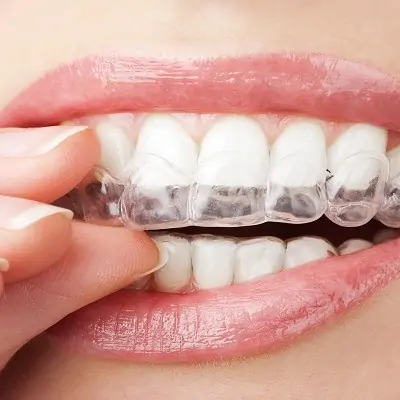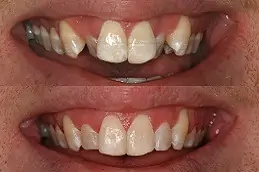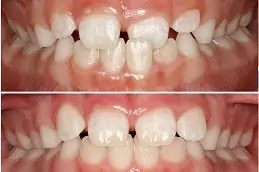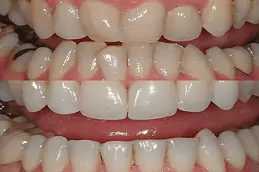Results:
The uneven and overlapping teeth are corrected by aligning the total width of all teeth and the length of the dental arch. The teeth move and appear more aligned and straight.
Quick Tip! Be sure to look at the photos before and after the correction of crowded teeth to ensure that a positive result is possible even in complex cases.
Stages:
There are several stages of the problem and depending on the severity of the anomaly:
-
Mild: There is only a slight deviation from the norm. When smiling, some defects are almost invisible.
-
Moderate: There is a displacement of the dentition by 6 to 7 mm. the defect begins to be visible to others.
-
Severe: At this stage, two or more dental units are displaced, and the shape of the dental arch changes.
Diagnosis:
A predisposition to pathology can be detected even in childhood if the dentist diagnoses the lack of space between the milk teeth during a planned visit of the baby. This is a confirmation that in a permanent bite, the child will not have room for erupting teeth.
Additional methods are often used to determine the cause and degree of deviations when diagnosing pathology in adult patients.
What will Happen if it Remains Untreated?
People often mistakenly believe that the overcrowding of teeth is just a cosmetic problem. However, the problem can cause many health issues:
Poor Dental Hygiene: It is more complicated to access all areas of the teeth and to use dental floss correctly, which causes the formation of bacterial plaque, in turn favouring the appearance of caries and tartar. Among other things, plaque is also responsible for bad breath.
Periodontal Disease: In severe cases where dental hygiene becomes difficult, the patient can suffer from gum inflammation and other periodontal diseases.
Enamel Deterioration: Enamel and teeth wear out and deteriorate more quickly.
Occlusion Problems: Overcrowding of the teeth can also lead to more severe occlusion problems.
Treatment Methods:
Depending on the form and severity of the pathology, and the cause of crowding on the patient’s individual characteristics, the specialist chooses the optimal methods of treatment. These methods include:
Braces:
Braces are the most common treatment for moderate to complex cases of crowding. They are able to correct the position of the teeth and put the smile in order, but this will take time, repeated visits to the specialist, and the patient to review some of his habits related to oral hygiene and eating.
After completing the course, it is necessary to wear a retainer to consolidate the achieved result.
Aligners:
These are transparent and rigid mouthguards, which, like braces, correct the position of the teeth.
Aligners, unlike braces, are invisible to others, do not require the patient to review eating habits, and do not injure the oral mucosa. They can be removed while brushing your teeth and eating.
Extraction:
This procedure helps to get the maximum amount of space in the dentition. Most often, the fourth or fifth teeth are removed, which allows you to free up about 8 mm of space.
Tooth extraction is not considered an independent therapeutic method, and it is usually combined with the installation of braces.
Veneers:
Veneers can be prescribed for mild crowding when a doctor has diagnosed a slight curvature of the teeth. With their help, the patient quickly eliminates the shortcomings and returns a beautiful smile.
Quick Tip! With crowded teeth, veneers can only solve a cosmetic problem.
Crowded Teeth Treatment (FAQ’s):
What Is The Best Treatment For Crowded Teeth?
Crowded Teeth can be corrected using braces or retainers if they are mildly crowded (4mm). For even less Crowded Teeth, the removal of a thin layer of enamel can be suggested by your dentist. However, for severe cases (8mm or more), tooth removal may also be considered.
How Do You Fix Crowded Teeth Fast?
There are many options including metallic braces, retainers, or surgery. To determine which treatment is best suited for your particular case, consider seeking professional advice to know which treatment will be the fastest and most feasible.
Do Crowded Teeth Get Worse?
Crowded Teeth push against each other and if left untreated, this can lead to further issues such as gum disease, cavities, etc. They also make oral hygiene more difficult and are therefore responsible for both aesthetic and medical issues.
How Long Is Treatment For Crowded Teeth?
Treatment time can vary on a case-to-case basis from anywhere between 6 months for milder cases to 2 years for more severe cases. The treatment is customized according to each patient and can involve the use of retainers, braces, or even tooth extraction in severe cases.
Do Crowded Teeth Hurt?
Crowded Teeth, if left untreated can result in many oral health concerns such as cavities, tooth decay, or gum disease. In some cases, they can cause “Temporomandibular Joint Disorder” (TMJ) which can cause a popping sound, ear pain & joint pain in the jaw bone.
Do Crowded Teeth Need To Be Removed?
Not all cases of Crowded Teeth require tooth removal. In milder cases, braces and retainers can straighten teeth. However, for more severe cases, tooth extraction or surgical intervention may be required to completely resolve the issue.
What Happens If You Don't Treat Crowded Teeth?
Crowded Teeth push against each other leading to early wear and even chipping. This can in turn cause decay, sensitivity, bacterial growth, plaque, overbite, and many other oral problems that could have been avoided by resolving the crowded teeth issue.
Will Crowded Teeth Get Worse?
Yes, early treatment is recommended because of the long-term effects of Crowded Teeth. These teeth can cause difficulty in chewing, infection, gum disease, and permanent damage due to the excessive grinding/pushing of teeth.
Book a Free Appointment!
There are several treatment options available for Crowded Teeth Treatment in Georgia, Tbilisi Fill out the consultation form below to have this procedure done with us and get a free appointment.





